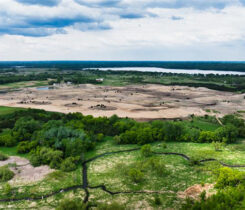Crane Creek Country Club completes three-year, $7M investment project
Crane Creek Country Club unveiled its new golf course and re-designed practice area. The re-opening of Crane Creek’s back nine marks the completion of a project encompassing two new indoor tennis courts and an outdoor stadium court, complementing a state-of-the-art tennis facility that now boasts five indoor and five outdoor courts.
In addition to bringing major course elements up to modern USGA technical specifications, much of the golf course work was done to improve specific aspects of the game. By using undeveloped land to create a new par four and par five on the back nine, the course will now play over 7,000 yards from the championship tees and play as a par 72 after 54 years as a par 71. While the course will be a tougher challenge for the low-handicap player, new tee boxes and approach shot considerations have been added for players that carry the ball shorter distances or tend to roll the ball along the ground. Thirty-five newly-designed on-course bunkers were also added.
While Crane Creek’s famous elevation changes still exist, they have been softened in some cases, and greens have been expanded in area to allow for a greater variety of pin placements. The course now offers a greater variety of setups for both tournament and daily play to accommodate varied player skill levels. In addition, the new greens are constructed with 007 Tyee Bentgrass to resist infestations of poa annua, an invasive grass common in the Treasure Valley, and drain water more effectively. This will lead to firmer greens that roll both true and fast with less ball mark damage or bumpiness caused by poa annua or soft conditions.
In addition to course renovations, Crane Creek Country Club now features an improved practice facility, two new practice greens for putting, a designated practice green for pitching and chipping, a doubling of full-swing hitting stations and a range that accommodates 300+ yard drives.
Practice facility improvements were made to accommodate the changing way today’s player sees the game — especially new players. What golf courses used to see as “driving ranges” are now becoming the center of social activity, from group lessons to skill competitions to junior golf events. “The game of golf is changing,” said Ron Rawls, head PGA professional. “Smart clubs are adapting not only to the changes in golf but to how private clubs can use the entirety of their facilities to enhance the lives of busy families.”
The plan began in 2010 with a masterplan called Vision 2020. The board of directors developed this initiative to prepare the golf course, tennis facilities, irrigation and parking infrastructure for the next generation by 2020. After 18 months of preparation by the board, a $6.5 million project was voted down by the members. Over the ensuing five years, six club presidents would lead the board and the club membership through two new proposals, two passing votes and three years of construction.
“We learned a lot from the Vision 2020 vote,” said 2014 president Jeff Cliff. “Foremost was the fact that we were biting off too much at once … basically the project was so comprehensive we gave everyone something they could disagree with and vote no.”
“We also learned how best to communicate with club members to best address their concerns and that timing of communication was critical,” added 2015 president, Edward Moore.
At the 2014 annual meeting, a Phase One plan was approved, developed by the 2013 board under Carey McNeal’s leadership. By September 2014, construction began on the front nine of the golf course, the tennis facilities, and the parking complex. The $3.7 million Phase One was completed in May 2015.
Following Phase One’s success, the 2015 board immediately started planning Phase Two, earning its approval at the 2016 annual meeting. “Phase Two was a difficult vote,” recalls Brooks Kochvar, 2016 president, “if for no other reason than we had just put our membership through a year of construction mess. Add the financial equation and we had a lot to explain and sell-in.”
The $7 million investment, approved by members in two phases, was financed through a combination of member assessments and a loan from the club’s banking partner, Idaho Independent Bank.
“We asked our members to invest in the future of this neighborhood club a half century after it was first built,” said Tyler Lund, current president of the club. “We shared a vision that the financial investment and three-year disruption of construction would be worth it for both current member families and for the next generation of members … and now we officially begin a new era at Crane Creek.”
“Tennis players are enjoying their second year with new courts and expanded facilities and now our golf community will begin to enjoy a completely renovated facility,” added Ben Hay, chief operating officer. “Add a fleet of brand new golf carts and some fresh interior design in the clubhouse and everything really sparkles.”
“One of the greatest accomplishments for this project was keeping the same vision of the Board of Directors and club for seven years.” said Ben Hay, chief operating officer. “We worked hard every year through Board Orientations to educate each new board member on what we were doing and why. Having that unified vision and then communicating it to the membership gave us great strength and determination to do what was right for the club for decades to come.”
In addition to new tees, greens and bunkers, another major aspect of the golf course renovation was addressing trees and landscaping with 50 years of age. “Planting new trees with a mind for how they will grow over the next 50 years is a major consideration,” said Tom DeGrandi golf course superintendent. “In addition we are also attempting to reduce erosion and mitigate flood damage for our downhill neighbors … it is a complex challenge.”
Design for the project was performed by golf architect David Druzisky, ASGCA, with landscaping and irrigation design by Baer Design Group, Greg Baer, PIC, PLA, and CGIA.










